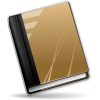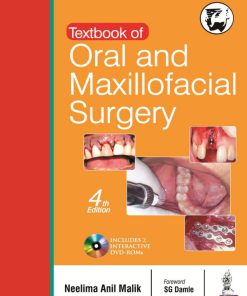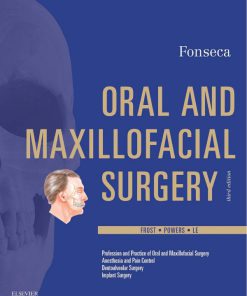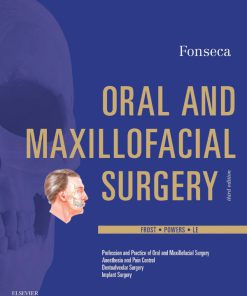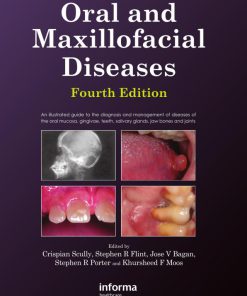Oral and Maxillofacial Trauma 4th Edition by Raymond Fonseca, Dexter Barber, Michael Powers, David Frost ISBN 9780323242035 0323242030
$50.00 Original price was: $50.00.$25.00Current price is: $25.00.
Authors:Saunders; 4 edition (December 20, 2012) , Author sort:edition, Saunders; 4 , Ids:978-1-4557-0554-2 , Publisher:www.elsevier.com/permissions.
Oral and Maxillofacial Trauma 4th Edition by Raymond Fonseca, Dexter Barber, Michael Powers, David Frost – Ebook PDF Instant Download/Delivery. 9780323242035 ,0323242030
Full download Oral and Maxillofacial Trauma 4th Edition after payment
Product details:
ISBN 10: 0323242030
ISBN 13: 9780323242035
Author: Raymond Fonseca, Dexter Barber, Michael Powers, David Frost
**Selected for Doody’s Core Titles® 2024 in Trauma Surgery** Describing the diagnosis and management of maxillofacial and associated traumatic injuries step by step, Oral and Maxillofacial Trauma, 4th Edition takes you beyond the surgical management of head and neck trauma to cover the general management of traumatic injuries, systemic evaluation of the trauma patient, and special considerations associated with maxillofacial trauma patient care. New to this edition are over 700 full-color illustrations showing details of traumatic injuries and their treatment. Edited by head and neck trauma expert Dr. Raymond J. Fonseca, along with over 80 highly respected contributors, this comprehensive reference provides all of the information you need to offer the best care possible to maxillofacial trauma patients.
- One-of-a-kind, comprehensive chapters cover current research literature with topics including advances in maxillofacial trauma surgery, nonpenetrating chest trauma, metabolic response to trauma, maxillofacial prosthetics, and the societal impact of maxillofacial trauma.
- Coverage of emerging topics includes firearm injuries, neurologic injuries (the leading cause of death from trauma), wound healing, airway management, shock, and nasal fractures, so you can work confidently with team members from other disciplines such as neurologists, anesthesiologists, and orthopedists.
- Over 80 expert contributors represent the specialties of oral and maxillofacial surgery, anesthesiology, and otolaryngology.
- UPDATED content reflects current thinking and the latest techniques in the management of traumatic injuries.
- NEW full-color illustrations and design highlight clinical areas and show details of injuries and their treatment.
- NEW! Streamlined, single-volume format makes information easier to access and the book easier to carry
Oral and Maxillofacial Trauma 4th Edition Table of contents:
Part I: Principles in the Management of Traumatic Injuries
Chapter 1: Metabolic Response to Trauma
Physiologic Response
Mediators of the Response
Clinical Implications
Summary
Chapter 2: Wound Healing
General Concepts of Wound Healing
Wound Repair in Other Tissues of the Head and Neck
Factors in Suboptimal Wound Healing
Wound Management
Summary
Chapter 3: Nutrition for the Oral and Maxillofacial Surgery Patient
Fasting- and Starvation-Induced Malnutrition Physiology
Trauma-, Stress-, and Sepsis-Induced Malnutrition Physiology
Substrate Depletion and Requirements
Assessment Tools for Diagnosis of Nutritional Failure
Nutritional Support Methods for Patients with Functioning Gastrointestinal Systems
Mechanics of Enteral Feeding
Enteral Diets
Parenteral Nutritional Therapy
Intermaxillary Fixation
Summary
Part II: Systematic Evaluation of the Traumatized Patient
Chapter 4: Initial Assessment and Intensive Care of the Trauma Patient
Patient Transport
Initial Assessment
Primary Survey
Secondary Assessment
Initial Management of the Trauma Patient in the Intensive Care Unit
Nonrespiratory Issues to Monitor in the Intensive Care Unit
Chapter 5: Emergency Airway Management in the Traumatized Patient
Systematic Approach to Airway Management
Pediatric Considerations
Summary
Chapter 6: Management of Nonpenetrating Chest Trauma
History of Chest Trauma
Motor Vehicle Accidents and Thoracic Injuries
General Management of Blunt Chest Trauma
Pneumothorax
Hemothorax
Hemopneumothorax
Pulmonary Contusion
Rib Fractures
Flail Chest
Fractured Sternum
Cervical Tracheal Disruption
Tracheobronchial Injuries
Esophageal Injuries
Penetrating Neck Trauma
Diaphragmatic Injuries
Rupture of the Aorta
Injuries of the Descending Thoracic Aorta
Myocardial Contusion
Chapter 7: Recognition and Management of Shock
Cellular Changes
Systemic Response
Major Categories of Shock
Treatment Principles
Summary
Acknowledgment
Chapter 8: Neurologic Evaluation and Management
Initial Assessment
Evaluation
Grading the Severity of Injury
Diagnostic Studies in Head Injury
Management of Head Injury
Cervical Spine Injury
Chapter 9: Abdominal Trauma: Evaluation and Management
Epidemiology
Mechanisms of Injury
Examination
Diagnostic Workup
Evaluation of Penetrating Injuries
Blunt Abdominal Injury
Pelvic Injuries
Pediatric Abdominal Trauma
Occult Abdominal Trauma
Abdominal Trauma in Pregnancy
Summary
Part III: Management of Head and Neck Injuries
Chapter 10: Applied Surgical Anatomy of the Head and Neck
Skin Lines and Lines of Langer
Scalp
Skin of the Face
Osteology
Mandibular Surgical Approaches
Intraoral Surgical Approaches
Muscles
Arterial Blood Supply to the Head and Neck
Veins of the Head and Neck
Neurologic Anatomy*
Regional Anatomy
Nasal Anatomy
Parotid Region
Floor of the Mouth
Acknowledgment
Chapter 11: Early Assessment and Treatment Planning of the Maxillofacial Trauma Patient
Airway (With Cervical Spine Protection)
Breathing and Ventilation
Circulation
Disability
Exposure
History of Present Illness
Review of Systems
Clinical Examination
Radiographic Evaluation
Postoperative Considerations
Acknowledgment
Chapter 12: Radiographic Evaluation of Facial Injuries
Maxillofacial Skeleton and Significance of Osseous Structures
Causes and Classification of Facial Injuries
Diagnostic Imaging of Maxillofacial Injuries
Facial Fractures
Summary
Chapter 13: Diagnosis and Management of Dentoalveolar Injuries
Examination and Diagnosis
Classification
Treatment
Mouth Protectors
Acknowledgment
Chapter 14: Mandibular Fractures
Historical Considerations
History of Treatment
Demographics and Epidemiology
Classification of Mandibular Fractures
Diagnosis of Mandibular Fractures
General Principles of Treatment
Open Reduction and Fixation Procedures
Endoscopic Repair
Complications of Mandibular Fracture Treatment
Summary
Acknowledgment
Chapter 15: Traumatic Injuries to the Mandibular Condyle
Condylar Neck Region Biomechanics
Classification of Temporomandibular Joint Fractures
Radiographic Evaluation of Condylar Fractures
Mandibular Condylar Fractures
Complications of Condylar Fracture Treatment
Condylar Fractures in Children
Physical Therapy for Condylar Fractures
Acknowledgment
Chapter 16: Fractures of the Zygomatic Complex and Arch
Anatomy
Terminology and Fracture Patterns
Classification of Zygomaticomaxillary Complex Fractures
Diagnosis of Zygomaticomaxillary Complex Fractures
Treatment of Zygomaticomaxillary Complex Fractures
Zygomatic Arch Fractures
Complications
Chapter 17: Diagnosis and Treatment of Midface Fractures
Le Fort Classifications
Emergency Care
Facial Examination
Le Fort Type I Fractures
Le Fort Type II (Pyramidal) Fractures
Palatal Fractures
Naso-Orbital-Ethmoid Injuries
Le Fort Type III Fractures
Malunion of Midface Fractures
Orbital Wall Fractures
Complications after Treatment of Midface Fractures
Lacrimal System
Emerging Surgical Techniques and Materials
Chapter 18: Ophthalmic Consequences of Maxillofacial Injuries
Ophthalmic Assessment
Minor Eye Injuries
Nonperforating Eye Injuries
Perforating Eye Injuries
Perforating Injuries of the Orbit
Retrobulbar Hemorrhage
Traumatic Optic Neuropathy
Disorders of Ocular Motility
Displacement of the Globe
Injuries to the Eyelids
Nasolacrimal Injuries
Indirect Ophthalmic Consequences of Injury
Relationship between Maxillofacial and Eye Injuries
Chapter 19: Evaluation and Management of Frontal Sinus Injuries
Development, Anatomy, and Function
Pathophysiology
History of Treatment
Overview of Clinical Decision Making
Diagnosis of Frontal Sinus Injuries
Management of Frontal Sinus Injuries
Complications in Frontal Sinus Injuries
Summary
Acknowledgments
Chapter 20: Nasal Fractures: Evaluation and Management
Function of the Nose
Epidemiology
Anatomy
Evaluation of Injury to the Nose
Treatment of Nasal Injuries
Post-Traumatic Deformity
Special Considerations for Pediatric Patients
Complications
Prevention of Nasal Injuries
Summary
Chapter 21: Management of Soft Tissue Injuries
Initial Examination
Anatomy of the Skin
Local Anesthesia
Suture Material
Surgical Needles
Wound Closure
Classification and Management of Soft Tissue Wounds
Injuries to Structures Requiring Special Treatment
Scar Formation
Burns
Chapter 22: Secondary Revision of Soft Tissue Injury
Soft Tissue Wound Healing
Principles of Wound Management
Preoperative Consultation
Scar Analysis
Timing of Scar Revision
Surgical Options
Complications
Specific Types of Scars
Resurfacing Procedures
General Postoperative Care for All Ablative Techniques
Adjunctive Scar Revision Procedures
Summary
Chapter 23: Management of Human and Animal Bites
Incidence of Bites
Pathophysiology
Treatment of Bite Injuries
Forensic Bite Mark Recognition, Evidence, and Analysis
Summary
Acknowledgments
Chapter 24: Diagnosis and Management of Traumatic Salivary Gland Injuries
Anatomy
Mechanism of Salivary Gland and Ductal Injuries
Diagnosis of Salivary Gland Injuries
Treatment of Salivary Gland Injuries
Management of Salivary Gland Injury Complications
Iatrogenic Injuries to the Salivary Gland
Chapter 25: Traumatic Injuries of the Trigeminal Nerve
Trigeminal Nerve Anatomy
Trigeminal Nerve Imaging
Classification of Trigeminal Nerve Injuries
Mechanisms of Injury to the Trigeminal Nerve
Clinical Neurosensory Testing
Microneurosurgery
Outcomes of Trigeminal Nerve Injury and Surgical Intervention
Part IV: Special Considerations in The Management of Traumatic Injuries
Chapter 26: Anesthetic Considerations in the Acutely Injured Patient
Importance of the Airway in Maxillofacial Trauma
Airway Examination and Management
Physical Examination
Anesthetic Strategies
Basic Principles of Management
Postoperative Airway Support
Summary
Chapter 27: Maxillofacial Ballistic and Missile Injuries
Epidemiology
Characteristics of Maxillofacial Ballistic and Missile Injuries
Acute Care Considerations
Management of Gunshot Wounds to the Face
Postoperative Complications
Summary
Chapter 28: Head and Neck Burn Injury
Epidemiology
Mechanisms of Burn Injury
Pathophysiology of Burns
Severity Index
Management
Summary
Chapter 29: Management of Pediatric Facial Fractures
Anatomic Considerations
Epidemiology of Facial Fractures
Diagnosis
Types of Fractures
Acknowledgment
Chapter 30: Oral and Maxillofacial Trauma in the Geriatric Patient
The Biology of Aging
System Changes
Nutrition
Psychosocial Issues
Soft Tissue Trauma and Wound Healing
Facial Fracture Management in the Geriatric Patient
Geriatric Trauma: Outcome and Survivability
Chapter 31: Reconstruction of Avulsive Defects of the Maxillofacial Complex
Causes of Avulsive Injuries of the Maxillofacial Complex
Incidence
Assessment and Initial Medical Management
Classification
Initial Surgical Management of Avulsive Maxillofacial Injuries
Reconstruction of Avulsive Soft Tissue Injuries
Adjunctive Therapy for Complete and Partial Soft Tissue Avulsions of the Maxillofacial Region
Reconstruction of Avulsive Hard Tissue Injuries
Midfacial and Upper Facial Third Reconstruction
Special Concerns
Chapter 32: Infection in the Patient with Maxillofacial Trauma
Causes of Infection
Management of Wounds
Preparation of the Patient for Surgery
Prophylactic Antibiotics
Early Detection of Infection
Treatment of Wound Infection
Infections Caused by Oral and Maxillofacial Trauma
Facial Bone Fractures
Treating the Patient with Viral Infection
summary
Chapter 33: Principles of Fixation for Maxillofacial Trauma
History of Fracture Treatment and Development of Modern Osteosynthesis
Biology of Bone and Bone Healing
Biophysics of the Facial Skeleton
Methods of Fixation
Rigid Versus Functionally Stable Fixation
Compression Plate Osteosynthesis
Noncompression Osteosynthesis
Lag Screws
Midface and Upper Face Fixation
Bioabsorbable Plate Fixation
Complications of Internal Fixation
Chapter 34: Minimally Invasive Oral and Maxillofacial Surgery Trauma
Endoscopic Treatment of Subcondylar Fractures
Endoscopic Treatment of the Frontal Sinus
Endoscopic Repair of the Zygomatic Complex Fracture
Endoscopic Repair of the Orbital Floor Fracture
Index
People also search for Oral and Maxillofacial Trauma 4th Edition:
management of oral and maxillofacial trauma
borrow oral and maxillofacial trauma
oral and maxillofacial trauma pdf
oral and maxillofacial trauma ppt



